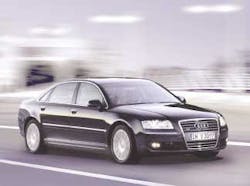Automotive laser technology on display
I can't think of a more qualified person to preview the upcoming Automotive Laser Applications Workshop (ALAW—Plymouth, MI—March 9–10) than Frank DiPietro. Frank spent most of his career at General Motors associated with body-in-white operations. You may not know that he was a driver behind the early 1980s adoption of laser roof welding at GM's Linden New Jersey assembly plant. Now in semi-retirement, Frank is a relentless advocate for laser in auto applications. He conceived of and organized the first ALAW 12 years ago and he has successfully arranged and chaired each successive event. I asked Frank to comment on the most outstanding aspects of this year's ALAW.
As the domestic auto industry strives to achieve manufacturing flexibility, it continues, in my opinion, to overlook a truly flexible process, laser welding. In the U.S., traditional resistance spot welding—basically an inflexible process—is the main process used to join the body-in-white. By contrast, most auto manufacturers outside of North America have vigorously implemented laser welding to weld the body-in-white. As a consequence, I contend that domestic auto manufacturers, including the transplants, are at least ten years behind in the implementation of laser material processing for the body-in-white. A real dichotomy! And one that this year's Automotive Laser Applications Workshop (ALAW) plans to put into perspective for a large automotive related audience.
The theme for the 12th annual ALAW 2004 is "Laser Technologies: Flexibility, Speed, and Innovation," attributes that are necessary for success in today's global automotive industry and industry in general. Laser material processing provides these benefits to the automotive industry and to manufacturing industries worldwide. To put the dichotomy into focus, one objective of the ALAW 2004 conference is to review the state of the art implementation of laser material processing and to discuss the disparities between its acceptance in North America and Europe, and the reasons behind it.
This year we are fortunate to have Klaus Loeffler, head of all joining processes for Volkswagen AG, as a keynote speaker. Volkswagen is the unquestioned world leader in the application of laser welding for body-in-white operations. They produce the Golf model, which is 75 percent laser welded, and which will be on display at ALAW. Loeffler's presentation will outline how lasers are being used successfully to produce these vehicles on a high-volume production basis. He will also show how VW is implementing this laser technology in several of its plants worldwide, with specific laser systems discussed. I consider Volkswagen's implementation of its high-power Nd:YAG laser welding systems for body-in-white operations to be at least ten years ahead of most global competitors. In my mind it demonstrates a strategy to achieve the ultimate in manufacturing flexibility for the body shop.
One of the "hot" laser technologies gaining implementation globally is remote laser welding (see page 9 of this issue). One form of remote laser welding uses an overhead scanner upon which a high-power laser beam is directed and focused precisely on a workpiece about 3–4 feet below the scanner. The resulting advantages include speed, accuracy, and flexibility. A special session on this topic will feature presentations on user applications in Germany, Italy, and the U.S., plus an analysis of benefits achieved. The different systems used for implementing remote laser welding will be reviewed coupled with the necessary product designs that enhance economic and flexibility benefits. The separation of the welding function from the tooling function in the total system enhances throughput while providing maximum flexibility and productivity with multiple laser welds per second commonplace in production systems.
Increasingly, remote laser welding systems are being installed in Japan, Europe, and North America to laser weld complete body-in-white body side panel assemblies, seat component sub-assemblies, power train components, and other components. Remote laser welding is particularly beneficial where high volumes of welds are required in short cycle times and flexibility between models is necessary.
Three new laser technologies that have been developed and are now production ready are: fiber laser, disk laser, and the diode laser. A special session will review and compare these lasers coupled with production applications for each. The attributes of these lasers will be reviewed and compared to traditional CO2 laser and the Nd:YAG laser, and the operating economics, reliability, and throughput will be evaluated for each laser system.
The use of laser direct metal deposition to create three-dimensional objects and the modification of tools and dies will be the subject of another session that will show examples of automotive and non-automotive applications. New systems and machinery now available will be discussed and the current system implementation in the European Union, Russia, and the U.S. will be discussed.
For the first time a session is devoted to applied laser beam diagnostics in industrial laser processing. The importance of laser beam monitoring, from a customer viewpoint, and related benefits that accrue will be discussed.
In summary, the latest worldwide laser applications, laser technologies, and future trends to meet the industrial challenges of flexibility, speed, and innovation are imbedded in this event.
The ALAW 2004 program and a registration option are available at http://cpd.engin.umich.edu.

